Having trained as a permaculture designer 30 years ago, I decided to turn the hillside plot (that came with my newly acquired home) into a permaculture garden. Very luckily for me, my husband to be, Peter, was a landscape gardener, who had similar views. Thirty years later, the rough hillside has been transformed into a beautiful wooded space with many layers of functionality, as well as being a haven for wildlife.

For anyone who doesn’t know about permaculture, it’s designing for sustainable living with fair share, people, creatures and planet care. Working with nature, rather than against it, it uses natural eco-systems as a model. There are many inspiring permaculture projects around the globe. If you are interested in exploring more, here is a link: https://www.permaculture.org.uk/knowledge-base/basics .
So- how did we start? We had an inaccessible hillside, covered in bracken and brambles, with a stream buried in a land drain and a few silver birch trees planted round the edges.
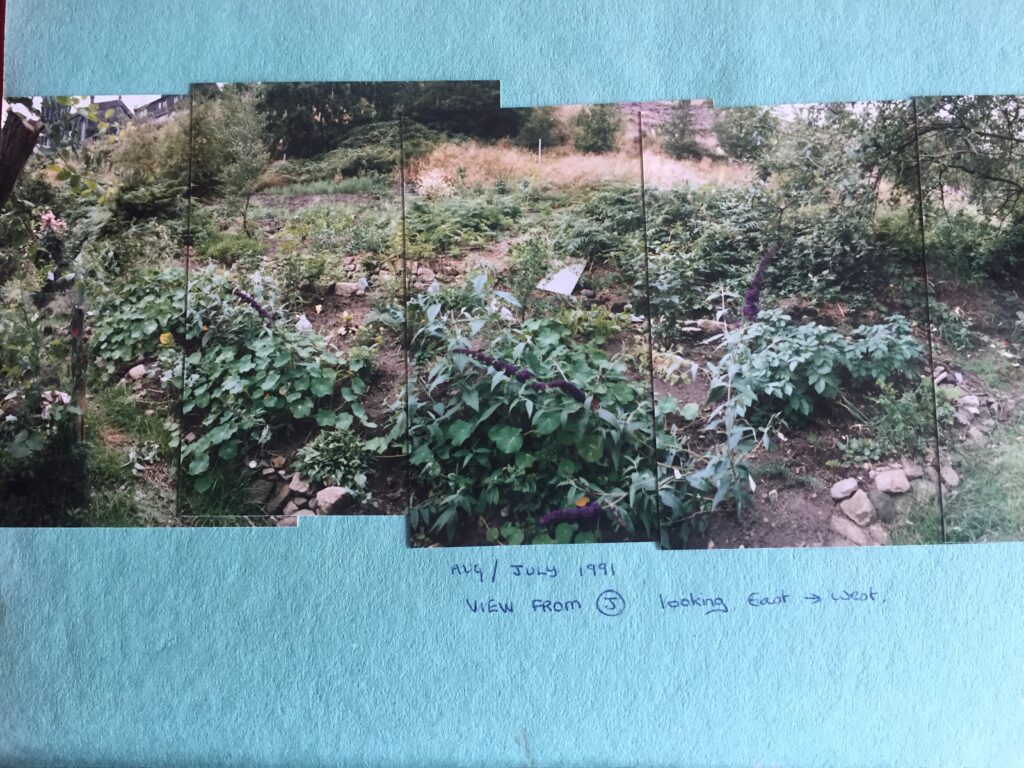
Peter terraced it so that we could walk round easily and created beds in which planting could take place. We then worked on improving the soil, using masses of manure to add to the bracken rich layer. He released the stream, creating ponds and a flow of water across the land, providing a useful source of this life giving liquid. The silver birch were left in place, as they are good nurse trees, fixing nitrogen into the soil and preparing the ground for others.

So what have we today?
Around the edges are bamboo, which provides a useful screen from the public footpath, lots of bamboo canes for creating structures like bean frames and plant supports and its roots hold the hillside together along a fault line.

Bamboo edging 
Bamboo supports for tomatoes 
Bean pole frame
Another edging plant is the hazel trees. These provide hazel nuts (mainly for the wildlife!!)and wood when we coppice them every seven years. The wood can be used for walking sticks, hurdles, charcoal and basic firewood. They shelter the public footpath and keep it relatively free from weeds.

The silver birch trees have prepared the way for a wide variety of trees that we’ve introduced. Eucalyptus (healing), Wild Service (edible fruits after being frozen and great for insects and birds), Sweet Chestnut (edible fruits), Butternut ( Peter grew them from some butternuts he was given for Christmas one year), Bay (useful for flavourings in stews) Witch Hazel (healing properties and bright flowers in January to lift the spirits!), Fig (edible fruit), Twisted hazel (great for flower arrangements), Yew ( ancient tree of protection) Rowan (great for birds and jam), Apple (edible fruit), Medlar (edible fruit), Pear (edible fruit), Oak ( great for all forms of wildlife), Gean Cherry (edible fruit, food for bees, birds and small mammals-lovely wood- we’ve a beam in our house made from one of the wild cherry trees in the garden), Tulip tree (beautiful flowers) Acers ( food for the eyes) Magnolia ( early flowers for bees), Weeping Mulberry (edible fruit), Elderberry ( a medicine chest in one tree plus food for birds and humans) and Himalayan Cedar .

The slanting eucalyptus 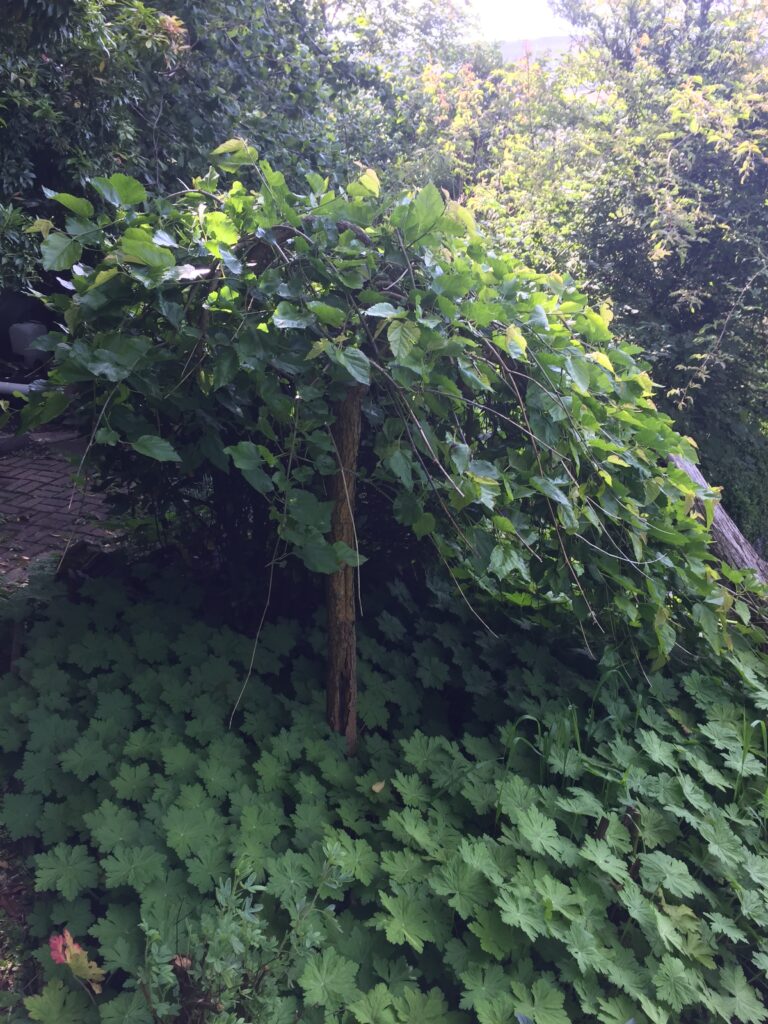
Weeping Mulberry 
Medlar (yet to ripen) 
Gean Cherry 
Fig 
Bay 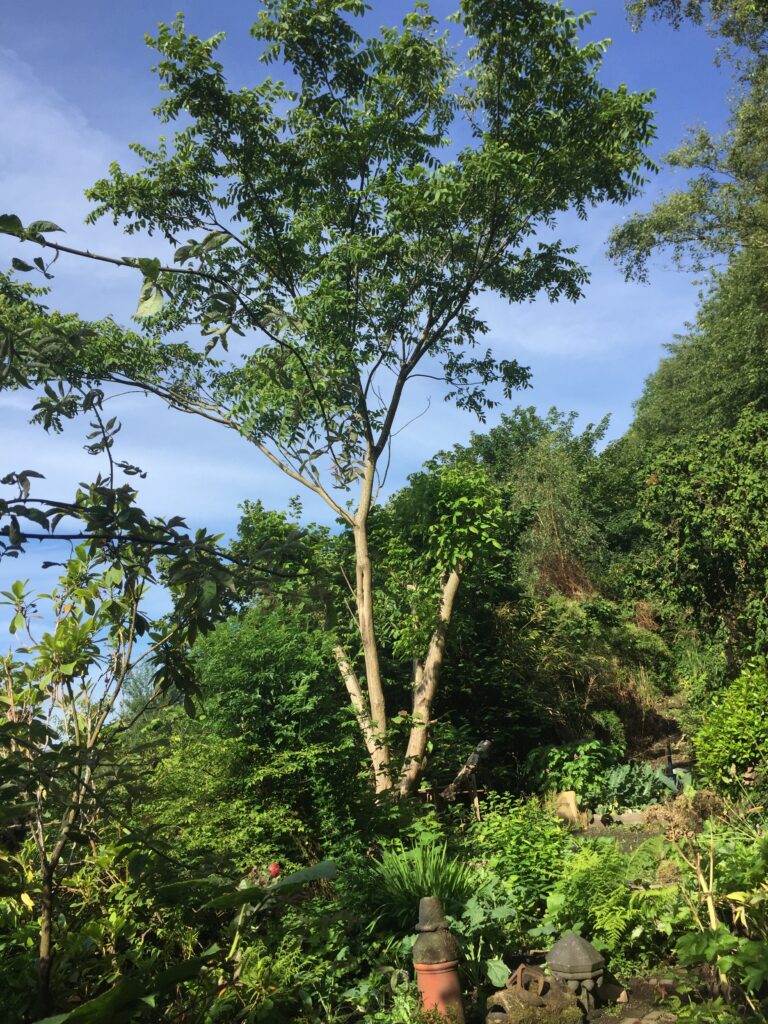
Butternut 
Wild Service
The church that was clearly visible above us when we first moved here has all but disappeared in the canopy of tree tops.

Years ago, Peter and I became friends with Robert Hart, the inspirational man who introduced the idea of forest gardening in a temperate climate to this country. https://www.youtube.com/watch?v=6zv3JxnjLEg -Sadly he passed away soon after the millenium but I am so pleased we can still see him in this lovely video, explaining his ideas.

Based on his ideas of creating a multi layered garden (to optimise the use of space and for the plants to beneficially support each other), we have included a bush layer, with gooseberries, worcesterberries, jostaberries, red and blackcurrants, raspberries, blueberries and bilberries.

Blueberry 
Gooseberry 
Jostaberry 
Worcesterberry 
Bilberry 
Raspberry
Then a herb layer, with rosemary, sage, fennel, rocket, angelica, chives, mint, bistort (they make a dock pudding from this in our local area) and a ground cover layer with comfrey, strawberries (alpine and cultivated) and marjoram.

Mint 
Angelica 
Fennel 
Sage 
Marjoram 
Alpine strawberry 
cultivated strawberry 
Comfrey 
Rosemary
In and amongst all these are flowering plants to attract birds, bees and butterflies.
The climbing plants that work their way up and around the other plants, include Japanes wineberry, thornless blackberry and a grape vine.

Grape vine 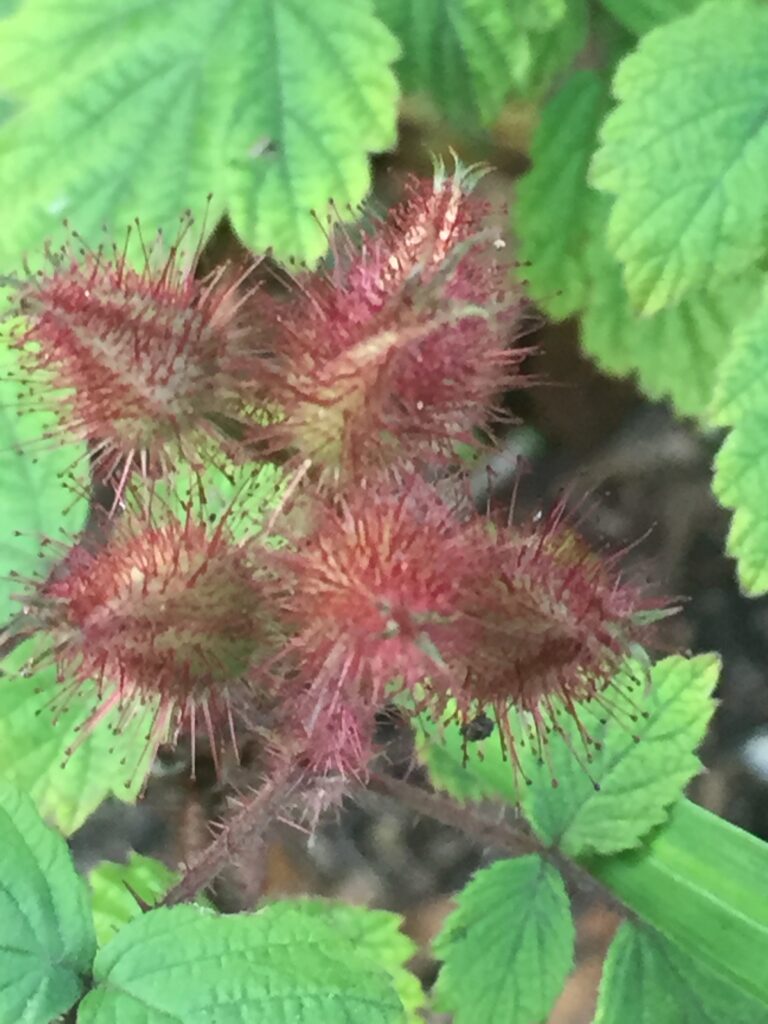
Japanese wineberry 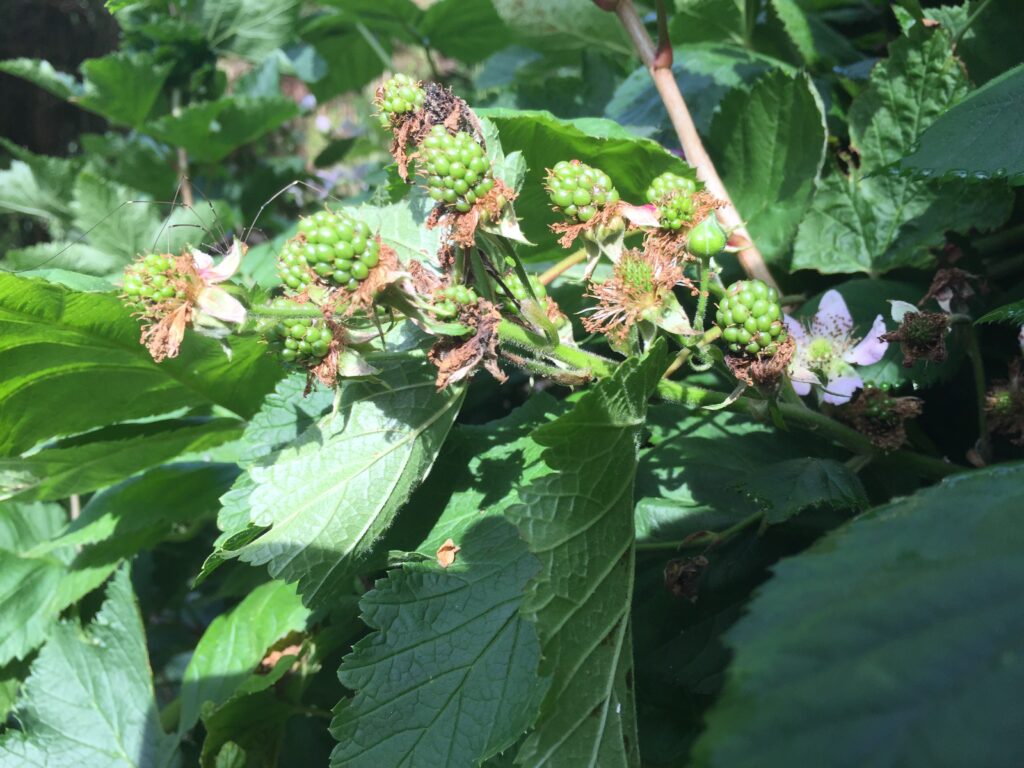
Thornless blackberry (not ripe yet!)
The beauty of all these plants is that they are perennial, or if not they seed themselves and keep reappearing in different parts of the garden as time goes on. The Angelica has moved all over! This permanent framework needs minimal maintenance and can either be left or inter-planted with annual vegetables, when we have the time and inclination.

As the garden has matured, we have discovered more and more creatures visiting it and feeding there.
Soon after doing the permaculture course, I dreamt that we went to visit a permaculture site in France. In the dream, I remember being astounded that the garden wasn’t just fruit and vegetables to eat. It was a stunning mass of flowers. In the dream I heard very clearly, “Vegetables are food for the body but flowers are food for the soul.” I have never forgotten that and when Peter started creating a beautiful border full of flowers for the front garden, I felt very happy indeed.

Eryngium 
Centaurea macrocephala 
Veronica blue spires 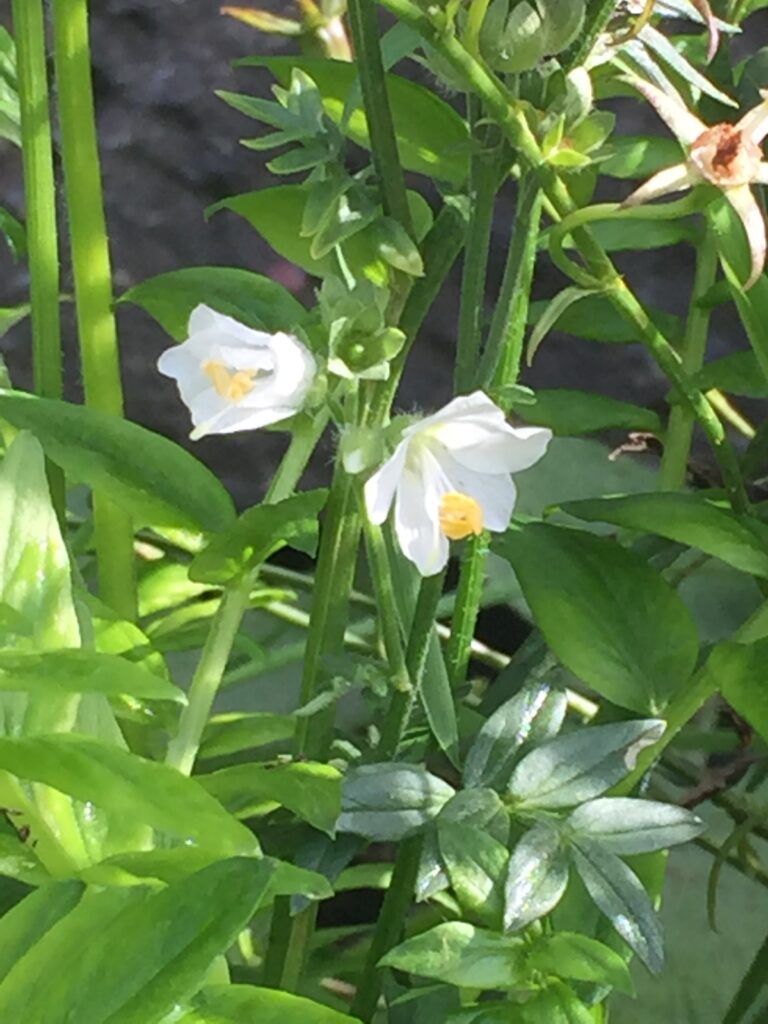
Polemonium white pearl 
Lysimachia Fire cracker 
Lychnis Chalcedonica 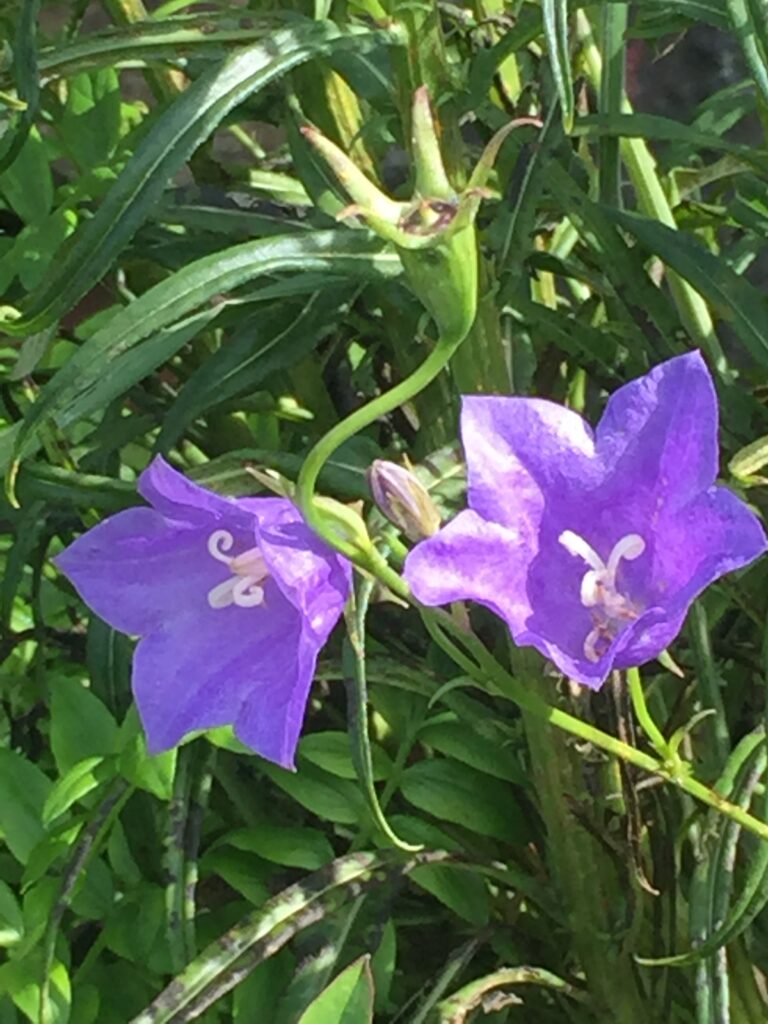
Campanula persicifolia 
Dianthus Granny’s favourite 
Geranium Patricia 
Geranium Brookside
The garden isn’t just about providing food for the body and flowers for the soul, its about creating a space for many things. It can host a large party or can conceal you from the world. It provides shelter from the sun, a space for quiet contemplation and for retreating and healing from different things life has thrown at us over the years. Our son has used it as a meeting place for his friends, I’ve slept among the trees on the tree platform and we also held our wedding party for 200 people there. Many people who visit our garden say it is a magical space, where they feel close to nature; they never know what they might discover and there is always something new to encounter. Whatever it is, it never ceases to amaze me how it has transformed and changed over the thirty years, always providing us with what we need on many different levels.

